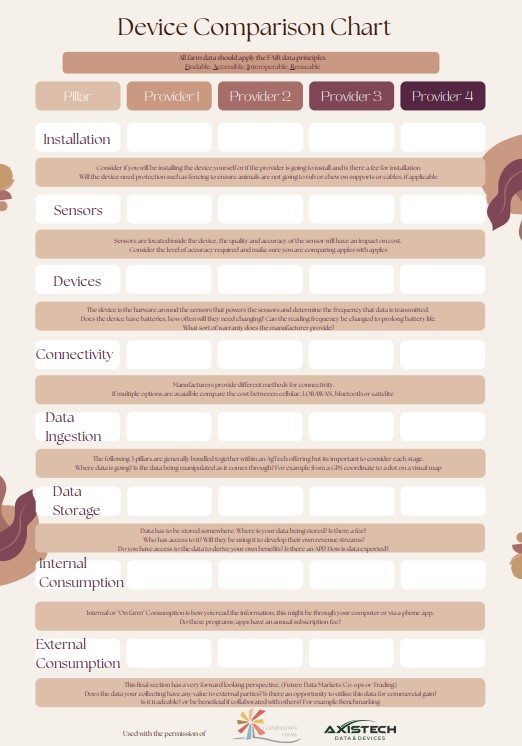8 Pillars of Agtech

The development and evolution of AgTech though has not been as simple as first thought. There have been many challenges, barriers, unknowns, learnings, successes, and failures to work through – not only for farmers but also for AgTech companies. AxisTech has been on its own journey with this too. Through our own learnings and collaborations, we have evolved our company to not only develop and produce devices that deliver data, but to play a more comprehensive role in the bigger picture of digitising agriculture.
Our founder, Wes Lawrence, in collaboration with Belinda Lay of Coolindown Farms, and of other fame, have arrived at an 8 Pillar framework that deconstructs solutions into their fundamental elements, or pillars. These 8 Pillars are based on their combined experience and learnings of IoT and other AgTech and create the foundation that each pillar is built on.
In November 2022 Belinda developed a ‘Device Decision Making Tool’ which can be accessed here.

Pillar 1: Installation
Installation is about firstly identifying the problem that needs solving and then understanding where that problem is physically located and assessing the physical environment in which an AgTech solution needs to live. Terrain, ease of access, soil type, infrastructure requirements, mounting brackets, environmental exposure, exposure to livestock and other animals, correctly orienting things like solar panels and wind direction sensors form just a handful of the challenges. The importance of the actual physical installation and key considerations in regard to environment and location is the first step in the process.
Pillar 2: Sensors
Sensors are the specific component in a device that undertakes key measurements. A device may have one or multiple sensors that may be external or internal. The data output and the nature of the solution is dependent on the sensors that exist within a device. Sensor quality and function is a component of data quality and reliability.
Pillar 3: Devices
The device manages, controls and powers itself and its sensors and communication modules. It manages sensor readings and packages them into messages and transmits them within its programmed format. Devices can also receive commands and perform functions within their physical, technological and power constraints.
Pillar 4: Connectivitiy
There is a plethora of connectivity options and terminology and it all fits together differently depending on where the installation is located relative to the existing or deployed infrastructure, and is usually multiple technologies. Bluetooth/BLE, WIFI, 3G/4G/LTE/Cat-M1/NB-IOT/5G cellular, LoRaWAN, Sigfox, ISM radio frequency, UHF, satellite, NBN, fibre, base stations, gateways, modems, last mile and backhaul all fit within this pillar.
Pillar 5: Data Ingestion
Separating data ingestion from storage allows a focus on device messages and how data flows are handled and then becomes meaningful data. It provides a framework for understanding of how batch and historical data can be handled, how farm records can be digitised, and covers the importance of attributes, units of measurement and the importance of data principles and data standardisation.
Pillar 6: Data Storage
Covers data management terminology like servers, cloud, AWS, Azure, SQL, databases, and data historians. It allows attention to be given to stored data: where is it, who holds it, who owns it, who has access to it and what is it being used for.
Pillar 7: On-Farm Data Consumption
Looks at applications, dashboards and apps with a focus on the farm or individual business level solution layer. Covers consumption of third party data such as satellite imagery as well vision from drones and cameras. Understanding layers of data can deliver a benefit to the farmer.
Pillar 8: Aggregated Data Consumption
Aggregated consumption is emerging as the new frontier with developing data sharing, data hubs, grouped displays, grouped machine learning, and 3rd party consumption of data for purposes, such as traceability and benchmarking.
We hope these 8 Pillars provide a meaningful framework by which to organise your knowledge and experience with AgTech. By developing a knowledge base of these 8 Pillars and understanding how they are connected we hope will assist the discussion, confidence and adoption of AgTech and the use of data into the next phase of on-farm efficiency, production and profitability and addressing social and ecological impact.
To paraphrase Christopher Reiss “Curiosity leads to knowledge, knowledge leads to wisdom, wisdom leads to insightful action.”
We are looking forward to sharing more of these 8 Pillars with you and continuing this digitisation of agriculture journey.
Belinda Lay
Belinda Lay is an Esperance Farmer and Winner of the 2019 WA Agrifutures Rural Women’s Award. Belinda is known for her sheep collar trials to address sheep livestock priorities including; animal welfare, improved lamb survival & the implementation of novel technology for commercial farm management.
Coolindown Farms is the first in Australia to use IoT devices to track animal welfare using the Sigfox network.
